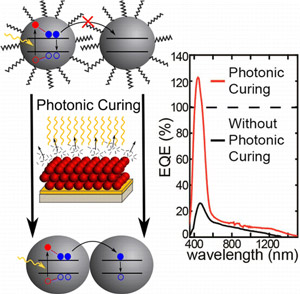- News
11 February 2014
Argonne and University of Texas team boost solar cells by capturing high-energy photons more efficiently
The US Department of Energy’s Argonne National Laboratory and the University of Texas at Austin have co-developed inexpensive material that has the potential to capture and convert solar energy — particularly from the bluer part of the spectrum — much more efficiently than before, it is claimed (C J Stolle et al, ‘Multiexciton Solar Cells of CuInSe2 Nanocrystals’, J. Phys. Chem. Lett., 2014, 5 (2), 304).
Most simple solar cells handle these bluish hues of the electromagnetic spectrum inefficiently. This is because blue photons striking the solar cell actually have excess energy that a conventional solar cell cannot capture. “Some photons come in with more energy than the cell is optimized to handle, and so a lot of that energy is lost as heat,” says University of Texas professor Brian Korgel.
Because of this limitation, scientists had originally believed that simple solar cells would never be able to convert more than about 34% of incoming solar radiation to electricity. However, about a decade ago, researchers saw the potential for a single high-energy photon to stimulate multiple excitons (pairs of a negatively charged electron and a positively charged hole) instead of just one. “We were still skeptical that we could get the electrons out of the material,” Korgel says.
His research team used specialized spectroscopic equipment at Argonne’s Center for Nanoscale Materials – one of the Department of Energy’s five Nanoscale Science Research Centers (NSRCs) – to look at multi-exciton generation in copper indium selenide (CIS), rather than the more commonly produced material copper indium gallium diselenide (CIGS) which holds the record for the most efficient thin-film photovoltaic cell. “This is one of the first studies done of multiple exciton generation in such a familiar and inexpensive material,” says Argonne nanoscientist Richard Schaller.
“Argonne’s spectroscopic techniques played a critical role in the detection of the multi-excitons,” Korgel says. “These kinds of measurements can’t be made many places.”
 Picture:
Peak external quantum efficiencies (EQEs) of just over 120% were observed in of CuInSe2 nanocrystal photovoltaic devices prepared by photonic curing. The extraction of more than one electron/hole pair as a result of the absorption of a single photon can occur if multiple excitons are generated and extracted.
Picture:
Peak external quantum efficiencies (EQEs) of just over 120% were observed in of CuInSe2 nanocrystal photovoltaic devices prepared by photonic curing. The extraction of more than one electron/hole pair as a result of the absorption of a single photon can occur if multiple excitons are generated and extracted.
To deposit thin films of the nanocrystalline material, the researchers used photonic curing (involving the split-second heating up and cooling down of the top layer of the material). This curing process not only prevents the melting of the glass that contains the nanocrystals, but also vaporizes organic molecules that inhibit multiple exciton extraction.
Although the study mostly proves that the efficiency boost provided by multiple exciton extraction is possible in mass-producible materials, the major hurdle will be to incorporate these materials into real-world devices.
“The holy grail of our research is not necessarily to boost efficiencies as high as they can theoretically go, but rather to combine increases in efficiency to the kind of large-scale roll-to-roll printing or processing technologies that will help us drive down costs,” Korgel says.
The study was supported by grants from the Department of Energy’s Office of Science and the US National Science Foundation (NSF).
http://pubs.acs.org/doi/abs/10.1021/jz402596v
www.che.utexas.edu/korgel-group


